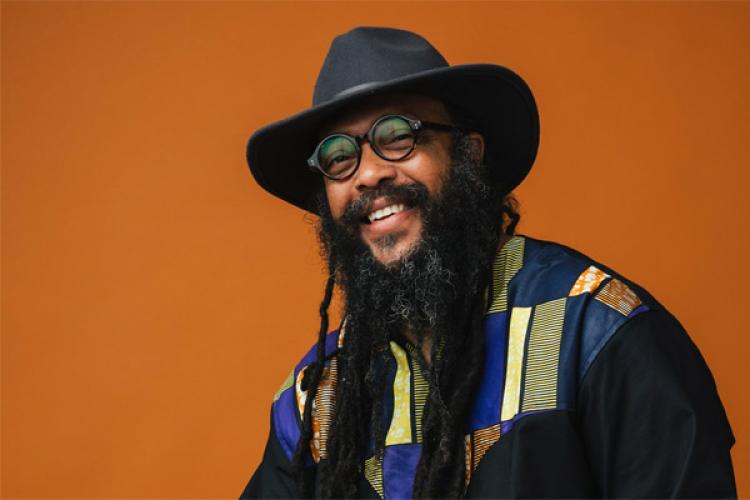
Uzoma Miller to talk about Black Ohio’s musical pop culture legacy on Sept. 16

Uzoma Miller will give a talk, accompanied by a DJ, on “Standing on the Funk: A Public Dialogue on Black Ohio’s Legacy of Musical Pop Culture” on Sept. 16, at 1 p.m. in Bentley Hall 129 during the Black Alumni Reunion.
His talk, which is free and open to the public, will touch on how African Americans from Ohio have penetrated and influenced mainstream culture.
“There can be no proper treatment of American pop culture without recognizing the significant role played by Black Ohioan musical artists,” said Miller, a visiting professor in African American Studies in the College of Arts and Sciences. He will discuss intersections of race, society and culture through the lens of musical contributions by Black Ohioans.
“Arguably, there probably are not many humans on the planet, from 5-to-95, who don’t know Michael Jackson’s music. The title single, ‘Off the Wall,’ from the 1979 album that propelled him from child prodigy and phenom to global superstardom, with 20 million selling copies, incorporates a disco-funk-laced lick with ties to Ohio," Miller said.
Miller will weave through generations and genres as he details the influence of Black Ohioans, including one of contemporary gospel’s most recognizable anthems and one of jazz’s most sophisticated musical stylists. He’ll also discuss one of the earliest documented blues recordings, present day hip-hop samples, and the Funk capital of the world.
“Droves from the iGen or Generation Z bounce and bob to Childish Gambino’s ‘Redbone,’ Kid Cudi’s ‘Metamorphosis,’ or ‘IMY2’ with Drake. But the direct and indirect Ohio connections to all these tunes may not be as ‘popular’ as these hits," Miller said. “Indeed, even Travis Scott’s ‘Flying High’ is accelerated by pulsating thump from Ohio.”
Miller also will show how Ohioans’ influence ranges from R&B to rap to the Rolling Stones.
“I’m never amazed at the high-volume consumption of, and adulation for, R&B music. Many, unfortunately, have a limited appreciation for the 'B' in the often-cited acronym: the Blues. Whereas the names Ma Rainey, Bessie Smith, and Billie Holiday are more commonly known, the earliest example of a blues record, which happened to sell a million copies in its first year, came from a woman artist from the banks of the Ohio River, adjacent to Kentucky, who paved the way for all other blues artists that followed,” Miller said.
“Regardless of who one asks, you would be hard-pressed to find a list of greatest rappers of all-time that doesn’t include Biggie Smalls (The Notorious B.I.G.) and Tupac on it. Multiple tracks from both artists, and from across the hip-hop landscape more broadly, are literally musical offspring of pure funk and silky soul from Ohio’s DNA,” he added. “And one of the top charting bands of all time, who still pack out stadiums pushing 80 years of age, the Rolling Stones, had a hit in 1964 that covers Ohio-based artists. There can be no discussion of American pop culture without paying homage to the sizeable contributions from Black Ohio.”
About Uzoma Miller
Miller is an alum of Morehouse College (B.A. history), Jackson State University (M.A. political science), and the California Institute of Integral Studies (Ph.D. Transformative Inquiry). His dissertation, "Dynamic Modes of Storytelling: A Reflexive Ethnography of Fisk University’s Cultural Resource Landscape," critically assessed how the institution’s community members know and apply their vast reservoir of artifacts, archival collections, art pieces and museums, and historic homes.
By providing a theoretical basis for experiential learning as pedagogy, Miller builds on 21 years of innovative higher and secondary education service through interdisciplinary fields and modalities across the Southeast region. He wrote 25 entries in Greenwood Press’s "Handbook of African American Business" (2006), and a well-cited monograph, “Talented 10th Revisited,” in 2011.
In 2022, Miller was a commissioned lecturer at Nashville’s Global Arts Center for the “Black Arts in America: Music of Oppression & Survival” series. He will serve as a commentator for “Educating the Black Public” at the 107th Meeting of the Association for the Study of African American Life & History and will chair “Archival Activism: Repatriation, Revitalization, and Agency” at the Society for Ethnomusicology’s 67th annual meeting held in conjunction with the American Musicological Society and Society for Musical Theory.
Miller’s current research is rooted in connecting dots between known and lesser-known artists with Historically Black College and University ties who have penetrated the popular music terrain.
